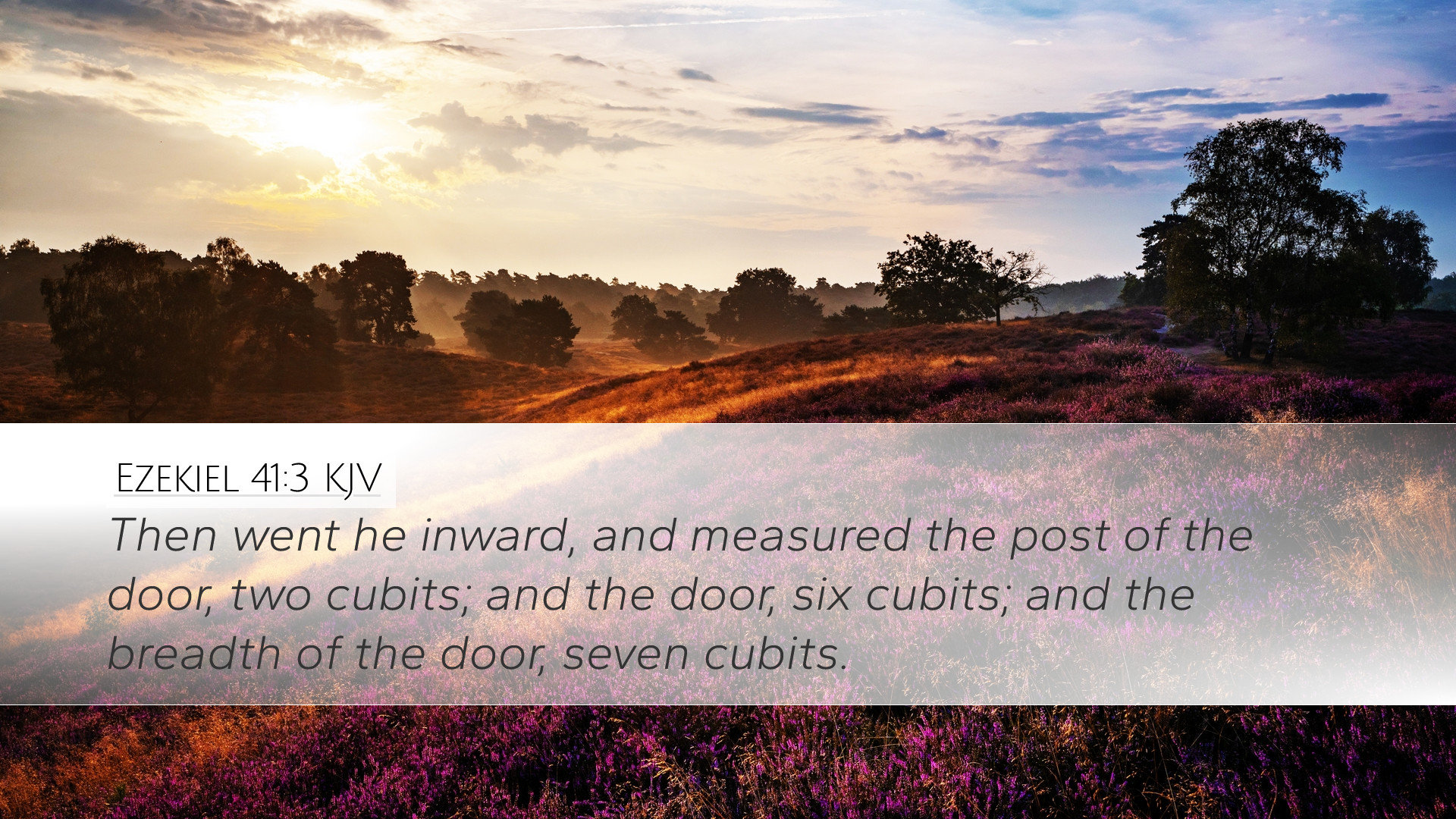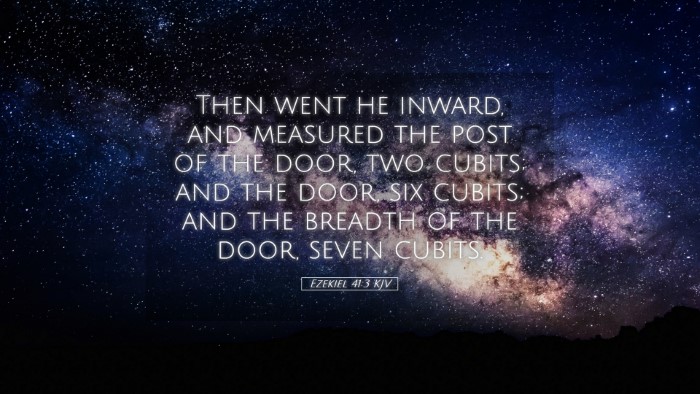Commentary on Ezekiel 41:3
Ezekiel 41:3: "And he went in, and measured the post of the door, two cubits; and the door of the temple was four cubits; and the breadth of the side posts, six cubits, which were on the sides of the temple."
This verse is part of Ezekiel's detailed vision of the Temple, which serves various purposes—primarily to provide hope to the exiles and to convey God's intent for restoration and worship. The measurements given reflect specific aspects of the design that require attention from theologians and scholars alike.
Context and Importance
The context of Ezekiel 41 is critical for understanding the significance of these measurements. The Temple described by Ezekiel is not merely a physical structure but represents God's presence among His people. It serves as a profound reminder of God’s fidelity and restoration in the face of exile and judgment. Both Matthew Henry and Albert Barnes emphasize that the vision underscores God's desire for a reconciled relationship with Israel.
Structural Analysis
When examining the dimensions provided in this verse, a few vital aspects stand out:
- Measurements as Symbolism: The measurements of the door and posts hint at God's meticulous order and design within the worship environment. Adam Clarke points out that the precise dimensions indicate a divinely inspired architecture aimed at holiness and reverence.
- Access to God: The door signifies access to God’s presence. The two cubit measurement of the post represents stability, suggesting that access to the divine is fortified by design. Matthew Henry notes that the stability of the door contributes to the overall sanctity of the Temple.
- Divine Specification: The focus on size and configuration may indicate that God has specific requirements for how He is to be approached in worship. Barnes comments that such meticulous design serves as a template for worship that ought to be followed, stressing the importance of adhering to divine guidelines.
Theological Implications
This verse presents various theological implications that resonate across various areas of Christian thought:
- God’s Presence: The design of the Temple—where God’s presence dwells—is essential for understanding the Old Testament covenant. The careful elaboration of the Temple architecture highlights God's intentionality in making His presence known among His people.
- Worship Structure: The structure represents the need for order and reverence in worship. As leaders and theologians reflect on worship contexts today, the emphasis on structure in Ezekiel’s vision may provide valuable lessons about creating environments that honor God.
- Sacrificial System: The Temple is central to the sacrificial system given to Israel. This verse could be seen as a precursor to an understanding of Jesus as the ultimate sacrifice, fulfilling and transcending the need for a physical Temple as the dwelling place of God.
Comparative Analysis
Comparing Ezekiel’s vision with related passages in the Pentateuch can offer additional insights:
- Exodus 25:9: The instruction to make the tabernacle according to the pattern shown illustrates continuity in the design directive from God. Barnes notes that these instructions to Ezekiel echo earlier temple designs to maintain continuity in worship across generations.
- 1 Kings 6: Here, the descriptions of Solomon's temple provide a historical benchmark. Clarke suggests that Ezekiel's details, while reflective of Solomon's temple, also adapt to the current cultural and spiritual climate faced by Israel in exile.
Pastoral Application
For pastors and spiritual leaders, Ezekiel 41:3 invites reflection on several practical applications:
- Preparation for Worship: Just as the Temple was a place which required specific measures for sacredness, congregations today may benefit from strategies that prepare hearts for worship.
- Teaching on Holiness: The detailed approach in this verse can encourage discussions about holiness and the seriousness of entering into the presence of God, prompting congregants to reflect on reverence in worship settings.
- Community Restoration: The vision holds significant implications regarding community life. It emphasizes the importance of rebuilding the place of worship after a period of spiritual desolation—an appealing theme for churches focusing on renewal and revitalization.
Conclusion
The insights drawn from Ezekiel 41:3, gathered from esteemed public domain commentaries such as those of Matthew Henry, Albert Barnes, and Adam Clarke, offer meaningful exploration into both the text and its implications. Through understanding the structure, purpose, and divine significance behind the measurements, pastors, students, and scholars are encouraged to deepen their appreciation for God’s design in worship and His continual call for His people to draw near.


